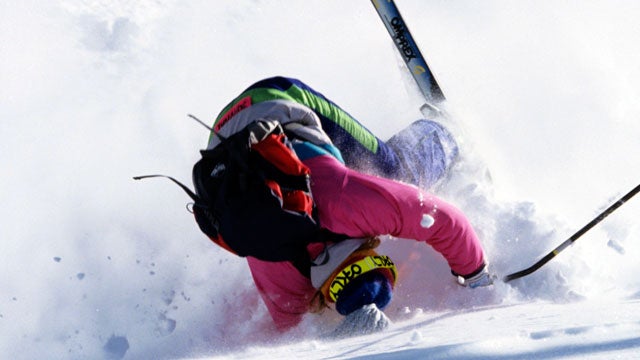Tommy Biesemeyer still remembers the feeling as he came popping over the top of that ill-fated jump. The was just seconds into the World Cup downhill in Bormio, Italy, last December—and approaching 65 miles per hour—when he hit a jump while still trying to turn and his skis shot out from under him. The downhiller landed with a thud on his side, sliding and spinning a few hundred yards down the icy slope before finally coming to a stop.
“Hitting (the jump) like that was like being on a loaded spring, like being double bounced on a trampoline,” says Biesemeyer, who skied away from the wipeout, but took a month to recover from a bruised kidney and torn abductor. It could have been far worse.
In retrospect, Biesemeyer says he was cutting the corners too straight, trying to make up time, taking a lot of risks. Still, even controlled skiers sometimes have their luck run out. If you do start to go down, a few tips—like the ones deployed by Biesemeyer in what otherwise might have been complete catastrophe—can help minimize the damage:��
Try to relax. Staying calm may be the last thing on your mind when you’re out of control, but tensing up the muscles increases the chance of injury. Don’t try to fight it. That way, your muscles, ligaments and joints can move naturally, and ideally in a way that will help you avoid a serious wreck.
Don’t dig in your edges. If your skis are still on, unless you’re headed toward trees or on a steep mogul field, don’t try to use your edges to slow yourself down. The sudden catch can tear ACLS or cause other knee injuries.
Aim your feet downhill. As you’re sliding, try to point your feet down the slope. You’ll protect your head and control the direction you’re moving.
Don’t put out your hand or arm to break the fall. The urge to brake with your limbs leads to damaged shoulders and broken collarbones. If you can, try to absorb the impact by rolling into the fall. “There is no such thing as falling a certain way to prevent injury completely, but you can fall in a way that disperses the impact of the fall on your whole body,” says Lindsey Winninger, lead physical therapist for the U.S. Women’s Ski Team. “For example, if your arm hits first, try to bend the elbow and roll onto your shoulder or hip.”
��
OF COURSE, A SMALL MEASURE of preparation is worth a few months of rehab. Jake Wurth, director of strength and conditioning at the , which is known for producing skiers like Lindsey Vonn and Chris del Bosco, works with youth and amateurs as well. For starters, Wurth has his athletes spend a lot of time on trampolines, in foam pits, and on tumbling mats.
“We call it air awareness, knowing where your body is in space,” says Wurth. “That way you know what it feels like to be off balance, making it more likely you’ll land right.”
Next, he has them work on moving, bending, and rotating properly. Wurth recommends getting a , which can be done by most doctors and physical therapists, to test your range of motion and identify weaknesses.
Then, build strong legs and core—the muscular chain from your knees to your ribcage that help transfer force. Wurth outlines five exercises that can help you fall artfully, or maybe even prevent the spill altogether. Try working three sets of 8-12 reps of the following exercises into your routine, with an emphasis on good form.
1.
Tighten your core and lower into a seated position as low as you can comfortably go. Make it harder by holding dumbells in each hand. Incorporate balance by doing the squat while on a Bosu ball.
2.
Get into a push-up position, with hips low, glutes activated and shoulder blades down, forming a straight line from your head to heels, and hold. Incorporate movement and increase the challenge by putting your elbows on a physio ball and making a circular movement with your elbows.
3.
Stand with arms in a T shape and lower torso while raising one leg. Return to standing. Make it harder by holding dumbells in front of you and doing a row or flys while in the lowered position.
4.
Stand knees slightly bent, holding a medicine ball with both hands, turned 90 degrees to a wall. From a few feet away, use your arms and torso to bounce the ball against the wall and catch it. Start slow and work to a faster pace. Switch sides.
5.
Plyometrics help you learn to land and absorb impact. Start with a simple vertical jump, landing with knees slightly bending to absorb shock. Make it harder by holding dumbells in each hand.


